|
The Other Garden Suburbs
 Brentham Garden Suburb in Ealing, West London, is no ordinary group of 620 houses. The first garden suburb to be built on 'Co-partnership' principles and an inspiration for the later, larger and more famous Hampstead, it has made a mark on twentieth-century domestic architecture, town planning and social housing out of all proportion to its size. The Labour, Co-operative, Arts and Crafts, and Garden City movements are all part of the Brentham story. The suburb was designed to a plan by the leading garden city architects Barry Parker and Raymond Unwin, with houses, mostly in the Arts and Crafts style, by George Lister Sutcliffe and Frederic Cavendish Pearson. In 1969 Brentham Garden Suburb was designated a conservation area. Brentham Garden Suburb in Ealing, West London, is no ordinary group of 620 houses. The first garden suburb to be built on 'Co-partnership' principles and an inspiration for the later, larger and more famous Hampstead, it has made a mark on twentieth-century domestic architecture, town planning and social housing out of all proportion to its size. The Labour, Co-operative, Arts and Crafts, and Garden City movements are all part of the Brentham story. The suburb was designed to a plan by the leading garden city architects Barry Parker and Raymond Unwin, with houses, mostly in the Arts and Crafts style, by George Lister Sutcliffe and Frederic Cavendish Pearson. In 1969 Brentham Garden Suburb was designated a conservation area.

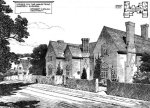 Hampstead Garden Suburb is located in North West London, England, approximately 7 miles from the centre of London. Founded in 1907 by Dame Henrietta Barnett, it is internationally recognised as one of the finest examples of early twentieth century domestic architecture and town planning, and home to approximately 13,000 people.
Hampstead Garden Suburb is located in North West London, England, approximately 7 miles from the centre of London. Founded in 1907 by Dame Henrietta Barnett, it is internationally recognised as one of the finest examples of early twentieth century domestic architecture and town planning, and home to approximately 13,000 people.
 The Oldham Garden Suburb owes its existence largely to the work of Mrs Higgs, one of the earliest members of the Garden Cities Association. The "Beautiful Oldham" movement had given an impulse to the desire for a better mode of living and a better style of home. Of the 52 acres one third was been developed by the Oldham Garden Suburb Tenants Ltd. Houses of a larger type were built for sale as well as for rent. The roads had been made with grass margins and are tree planted, and three acres were reserved for open spaces. The Oldham Garden Suburb owes its existence largely to the work of Mrs Higgs, one of the earliest members of the Garden Cities Association. The "Beautiful Oldham" movement had given an impulse to the desire for a better mode of living and a better style of home. Of the 52 acres one third was been developed by the Oldham Garden Suburb Tenants Ltd. Houses of a larger type were built for sale as well as for rent. The roads had been made with grass margins and are tree planted, and three acres were reserved for open spaces.
 In the context of the Victorian era, in which it was conceived, the creation of Port Sunlight Village by William Hesketh Lever was unparalleled. The tumultuous changes wreaked by the Industrial Revolution still had not been fully embraced even as late as the early twentieth century. The combination of a content, healthy and efficient workforce was a vision held by some philosophers and luminaries of the time but Lever was one of the first entrepreneurs to realise such a dream. From his middle-class upbringing in Bolton, Lancashire to his ambitious trips around the world, Lever employed lessons learned to good effect in housing and employing the workforce of his soap business. In the context of the Victorian era, in which it was conceived, the creation of Port Sunlight Village by William Hesketh Lever was unparalleled. The tumultuous changes wreaked by the Industrial Revolution still had not been fully embraced even as late as the early twentieth century. The combination of a content, healthy and efficient workforce was a vision held by some philosophers and luminaries of the time but Lever was one of the first entrepreneurs to realise such a dream. From his middle-class upbringing in Bolton, Lancashire to his ambitious trips around the world, Lever employed lessons learned to good effect in housing and employing the workforce of his soap business.
 Saltaire is a purpose-built "model" Victorian industrial village, next to Shipley and just to the north of the centre of Bradford in West Yorkshire's Bronte Country. The village itself was built in the nineteenth century by the Victorian philanthropist Sir Titus Salt, to provide self-contained living space for the workers at his woollen mills, a welcome alternative to the then "dark satanic mills" of Bradford and Leeds. Saltaire is a purpose-built "model" Victorian industrial village, next to Shipley and just to the north of the centre of Bradford in West Yorkshire's Bronte Country. The village itself was built in the nineteenth century by the Victorian philanthropist Sir Titus Salt, to provide self-contained living space for the workers at his woollen mills, a welcome alternative to the then "dark satanic mills" of Bradford and Leeds.
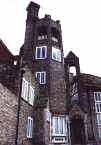 In 1898, Ebenezer Howard, appalled at the very unpleasant living and working conditions in the late 19th Century towns and cities, wrote a book outlining his ideas for a completely new way of living. The book, 'Tomorrow, A Peaceful Path to Real Reform', was later republished as 'Garden Cities of Tomorrow' in 1902. Ebenezer Howard believed that the very best of both town and country life should be married together in small Garden Cities, each with its own greenbelt. He promoted well-planned towns with careful land zoning and a quality of life. A Garden City would have well designed houses with gardens set in tree lined avenues, clean and healthy work places and a pleasant and healthy environment in which to live, work and follow leisure pursuits. 'There are in reality not only, as is so constantly assumed, two alternatives - town life and country life - but a third alternative, in which all the advantages of the most energetic and active town life, with all the beauty and delight of the country, may be secured in perfect combination. Human society and the beauty of nature are meant to be enjoyed together.' In 1898, Ebenezer Howard, appalled at the very unpleasant living and working conditions in the late 19th Century towns and cities, wrote a book outlining his ideas for a completely new way of living. The book, 'Tomorrow, A Peaceful Path to Real Reform', was later republished as 'Garden Cities of Tomorrow' in 1902. Ebenezer Howard believed that the very best of both town and country life should be married together in small Garden Cities, each with its own greenbelt. He promoted well-planned towns with careful land zoning and a quality of life. A Garden City would have well designed houses with gardens set in tree lined avenues, clean and healthy work places and a pleasant and healthy environment in which to live, work and follow leisure pursuits. 'There are in reality not only, as is so constantly assumed, two alternatives - town life and country life - but a third alternative, in which all the advantages of the most energetic and active town life, with all the beauty and delight of the country, may be secured in perfect combination. Human society and the beauty of nature are meant to be enjoyed together.'
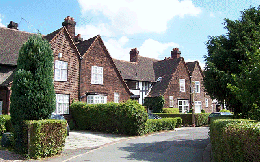 Wavertree Garden Suburb - or the Liverpool Garden Suburb as it was originally called - was one of about 20 or so similar developments planned and built up and down the country in the decade prior to the First World War. It was a co-partnership housing scheme, the houses being owned neither individually nor by a profit-seeking private landlord. The owner of the whole estate was a company called Liverpool Garden Suburb Tenants Ltd, in which the tenants of the houses were themselves shareholders. Shares could also be purchased by outsiders. The idea of building a Garden Suburb here came not from Liverpool but from London. Henry Vivian, the first Chairman of Liverpool Garden Suburb Tenants Ltd was also Chairman of Co-partnership Tenants Ltd, a London-based organisation dedicated to establishing Garden Suburbs all over the country. Wavertree Garden Suburb - or the Liverpool Garden Suburb as it was originally called - was one of about 20 or so similar developments planned and built up and down the country in the decade prior to the First World War. It was a co-partnership housing scheme, the houses being owned neither individually nor by a profit-seeking private landlord. The owner of the whole estate was a company called Liverpool Garden Suburb Tenants Ltd, in which the tenants of the houses were themselves shareholders. Shares could also be purchased by outsiders. The idea of building a Garden Suburb here came not from Liverpool but from London. Henry Vivian, the first Chairman of Liverpool Garden Suburb Tenants Ltd was also Chairman of Co-partnership Tenants Ltd, a London-based organisation dedicated to establishing Garden Suburbs all over the country.
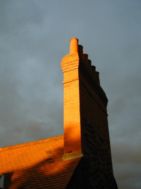 It can be justly described as the world's first garden suburb. Although it was not built in the cooperative manner like some later developments (Brentham Garden Suburb, Hampstead Garden Suburb and Moor Pool Garden Suburb) it created a model that was emulated not just by the Garden city movement, but suburban developments around the world. Sir John Betjeman described Bedford Park "the most significant suburb built in the last century, probably in the western world". Herman Muthesius, the celebrated German critic who wrote The English House in 1904 said "It signifies neither more nor less than the starting point of the smaller modern house, which spread from there over the whole country." It can be justly described as the world's first garden suburb. Although it was not built in the cooperative manner like some later developments (Brentham Garden Suburb, Hampstead Garden Suburb and Moor Pool Garden Suburb) it created a model that was emulated not just by the Garden city movement, but suburban developments around the world. Sir John Betjeman described Bedford Park "the most significant suburb built in the last century, probably in the western world". Herman Muthesius, the celebrated German critic who wrote The English House in 1904 said "It signifies neither more nor less than the starting point of the smaller modern house, which spread from there over the whole country."
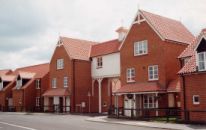 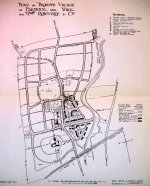 The garden village of New Earswick was formed by Joseph Rowntree (1835-1925), the successful York businessman who built up the cocoa and confectionery business which bore his name. The garden village of New Earswick was formed by Joseph Rowntree (1835-1925), the successful York businessman who built up the cocoa and confectionery business which bore his name.
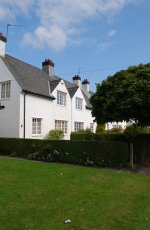 Rhiwbina Garden Village, Rhiwbina, Glamorgan, is perhaps the best example of a Garden Village scheme in Wales. The company, which was formed in 1912, was originally called the Cardiff Worker's Co-operative Garden Village Society Ltd, but this name was changed soon afterwards to the Rhiwbina Garden Village Ltd. This public utility housing society was established under the auspices of the Welsh Town Planning and Housing Trust Ltd. The main objective of which was the provision of modern houses located in pleasant and healthy surroundings in the Rhiwbina area. To this end, the society bought 110 acres of land from the Pentwyn Estate, at £200 per acre, and by Christmas 1913, 34 houses had been built. Each of these houses was supplied with water, gas for cooking and lighting, a boiler, a water-storage tank and a dustbin. Fences and hedges were erected and paths were laid. The village was run by a committee elected by the tenants, each of whom had one vote at an annual general meeting. At this meeting, the committee for the new year would be elected, and shareholders would have a report on the work done by the committee for the previous year. As the village grew, the work of administration became so heavy that a paid company secretary was appointed, with an office at Cathedral Road, Cardiff. Nevertheless, the financial affairs of the village were managed so well that by the 1960s, all the money advanced by the Welsh Town-Planning and Housing Trust to buy and build, had been repaid. Consequently, the society owned all the houses in the village and the land on which they were built. Therefore, because the Rhiwbina Garden Village Limited had always been a non-profit-making organisation, the committee decided in 1968 to sell the houses to the occupiers. After which, on the 27th May 1976, the shareholders decided unamiously that the necessary steps be taken for the voluntary winding-up of the Rhiwbina Garden Village Limited. The company was finally dissolved in 1981. Rhiwbina Garden Village, Rhiwbina, Glamorgan, is perhaps the best example of a Garden Village scheme in Wales. The company, which was formed in 1912, was originally called the Cardiff Worker's Co-operative Garden Village Society Ltd, but this name was changed soon afterwards to the Rhiwbina Garden Village Ltd. This public utility housing society was established under the auspices of the Welsh Town Planning and Housing Trust Ltd. The main objective of which was the provision of modern houses located in pleasant and healthy surroundings in the Rhiwbina area. To this end, the society bought 110 acres of land from the Pentwyn Estate, at £200 per acre, and by Christmas 1913, 34 houses had been built. Each of these houses was supplied with water, gas for cooking and lighting, a boiler, a water-storage tank and a dustbin. Fences and hedges were erected and paths were laid. The village was run by a committee elected by the tenants, each of whom had one vote at an annual general meeting. At this meeting, the committee for the new year would be elected, and shareholders would have a report on the work done by the committee for the previous year. As the village grew, the work of administration became so heavy that a paid company secretary was appointed, with an office at Cathedral Road, Cardiff. Nevertheless, the financial affairs of the village were managed so well that by the 1960s, all the money advanced by the Welsh Town-Planning and Housing Trust to buy and build, had been repaid. Consequently, the society owned all the houses in the village and the land on which they were built. Therefore, because the Rhiwbina Garden Village Limited had always been a non-profit-making organisation, the committee decided in 1968 to sell the houses to the occupiers. After which, on the 27th May 1976, the shareholders decided unamiously that the necessary steps be taken for the voluntary winding-up of the Rhiwbina Garden Village Limited. The company was finally dissolved in 1981.
 Welwyn Garden City (WGC), as its name suggests, is a garden city, founded by Sir Ebenezer Howard in the 1920s following his previous experiment in Letchworth Garden City, and designed by Louis de Soissons. Howard had called for the creation of new towns of limited size, planned in advance, and surrounded by a permanent belt of agricultural land, as a role model for lower-density urban development. Howard believed that such Garden Cities were the perfect blend of city and nature. Welwyn Garden City (WGC), as its name suggests, is a garden city, founded by Sir Ebenezer Howard in the 1920s following his previous experiment in Letchworth Garden City, and designed by Louis de Soissons. Howard had called for the creation of new towns of limited size, planned in advance, and surrounded by a permanent belt of agricultural land, as a role model for lower-density urban development. Howard believed that such Garden Cities were the perfect blend of city and nature.
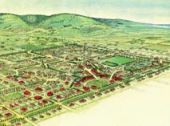 Colonel Light Gardens is a model garden suburb, featuring wide, tree-lined streets, rounded street corners, and lots of open space, located within the City of Mitcham in the greater City of Adelaide, capital of South Australia. The area is 1.58 km². It contains Colonel Light Gardens Primary School, the Colonel Light Gardens RSL, a number of sporting clubs using the name Reade Park, and a multitude of historical parks and gardens. It also contains many paved and unpaved laneways, alleyways and bike tracks, most of which do not appear on maps. Colonel Light Gardens is a model garden suburb, featuring wide, tree-lined streets, rounded street corners, and lots of open space, located within the City of Mitcham in the greater City of Adelaide, capital of South Australia. The area is 1.58 km². It contains Colonel Light Gardens Primary School, the Colonel Light Gardens RSL, a number of sporting clubs using the name Reade Park, and a multitude of historical parks and gardens. It also contains many paved and unpaved laneways, alleyways and bike tracks, most of which do not appear on maps.
 Haberfield was established as an estate in 1901, the year of Australia's Federation. It was built following the overseas Garden Estate movement, which was a reaction to closer, 'insanitary' settlements of the earlier suburbs. When establishing the estate, Richard Stanton used the slogan "Slum-less. Lane-less. Pub-less." This indicated that he was designing a 'genteel', residential suburb of free standing brick houses which did not need back lanes because every house was sewered. Haberfield was established as an estate in 1901, the year of Australia's Federation. It was built following the overseas Garden Estate movement, which was a reaction to closer, 'insanitary' settlements of the earlier suburbs. When establishing the estate, Richard Stanton used the slogan "Slum-less. Lane-less. Pub-less." This indicated that he was designing a 'genteel', residential suburb of free standing brick houses which did not need back lanes because every house was sewered.
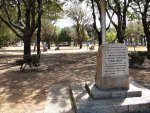 The "garden city" suburb of Pinelands is located on the edge of the southern suburbs of Cape Town in South Africa and is known for its large thatched houses. The suburb is primarily residential and is often praised for its peacefulness and abundance of trees. Pinelands is one of the few areas in Cape Town in which sale of alcohol is prohibited and is a popular place for senior citizens to retire to. While there are several retirement homes in the suburb, younger people are increasingly moving in. The "garden city" suburb of Pinelands is located on the edge of the southern suburbs of Cape Town in South Africa and is known for its large thatched houses. The suburb is primarily residential and is often praised for its peacefulness and abundance of trees. Pinelands is one of the few areas in Cape Town in which sale of alcohol is prohibited and is a popular place for senior citizens to retire to. While there are several retirement homes in the suburb, younger people are increasingly moving in. |